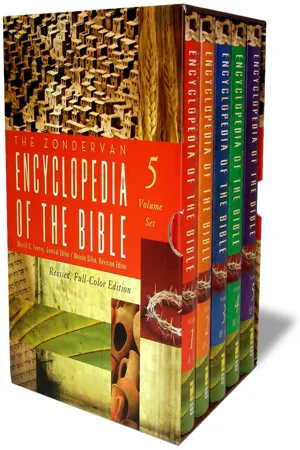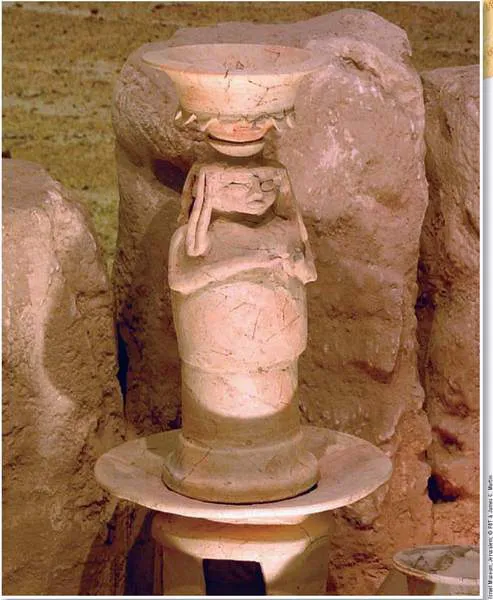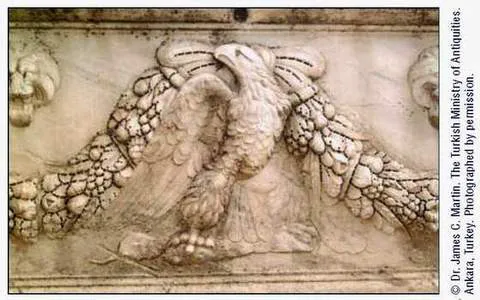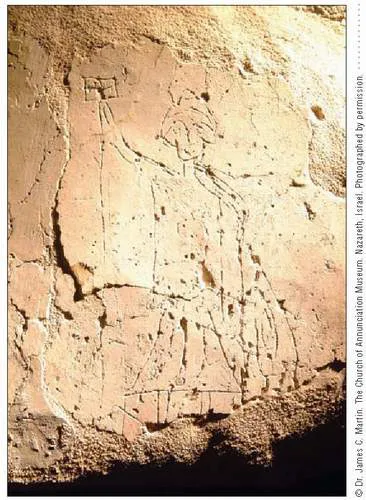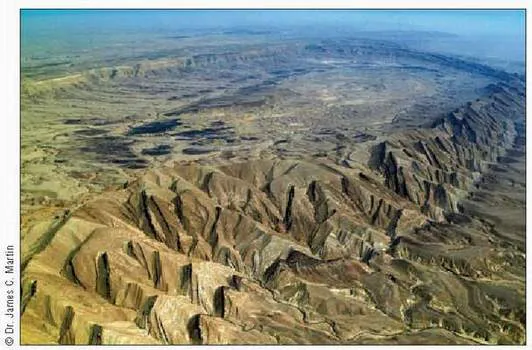![]()
E
Edomite cult stand (7th—6th cent. B.C.) discovered at (Ain Ḥuṣb (biblical Tamar).
E. An abbreviation for ELOHIST; it is used (along with D, J, and P) to designate one of the supposed sources of the PENTATEUCH, according to the Documentary Hypothesis.
eagle. The eagle (referring to the imperial eagle, Aquila heliaca, or the golden eagle, A. chrysaetus) is mentioned in the OT more frequently than the other BIRDS OF PREY. Its position at the head of the Levitical table (nešerH5979, Lev. 11:13) suggests great size, a feature implied in several contexts (e.g., Exod. 19:4, “I carried you on eagles’ wings”). Other attributes are swiftness and strength (cf. Jer. 49:22). It is said to fly high in the heavens, making its “nest among the stars” (Obad. 4).
These facts would apply to either eagles or VULTURES, and Palestine is rich in these birds. Eagles include the following: imperial, golden, spotted, lesser spotted, Bonelli’s, booted, tawny, Verraux’s, short-toed, and white-tailed. There are black-bearded, griffon, and Egyptian vultures. The context in Mic. 1:16 (“Make yourselves as bald as the nešer”) suggests the griffon vulture, whose head is covered with short creamy down, giving the appearance, at a distance, of being bare. The Greek term aetosG108 clearly refers to the vulture in Matt. 24:28 (= Lk. 17:27), “Wherever there is a carcass, there the vultures will gather.” In the book of Revelation, the word apparently refers to the eagle (Rev. 4:7 et al.).
Few people today, other than experienced naturalists, can distinguish between these birds, usually seen at great distances and heights, where color cannot be distinguished. The Hebrew and Greek terms can thus be taken as embracing them all. Several figurative passages reflect interesting beliefs. The comment that an eagle “stirs up its nest” (Deut. 32:11) implies that a hen eagle deliberately disturbs the young, persuades them to take off, and then catches them on her wings if need be, but this has little basis in fact. Young birds spend long periods alone at the nest, especially as they grow older. Between eight and twelveweeks, according to species, the juvenile becomes fully feathered and begins flapping and exercising its wings, finally becoming airborne. The proverb that riches “fly off to the sky like an eagle” (Prov. 23:5) may be connected with an ancient belief that the eagle disappeared into the sun every ten years, to dive down into the sea, like the sun, and emerge refreshed. PLINY the Elder wrote of the eagle forcing her young to look straight against the sun’s beam (Nat. Hist. 10.3 §10).
The biology of eagles in Palestine is too varied to treat. About three species breed in tall trees or, more often, on cliffs. The others are passing migrants or winter visitors. They feed mostly on live prey, which ranges from young deer to reptiles and insects. (See G. R. Driver in PEQ no vol. [1955]: 5-20; FFB, 82-85.)
G. S. CANSDALE
Relief of an eagle on a sarcophagus discovered in Antioch of Syria.
Eanes ee’uh-neez. KJV Apoc. variant of MAASEIAH (1 Esd. 9:21).
ear. The vital organ of hearing. While the Bible often refers to the ear in the physical sense, more frequently the use of the term (Heb. )ōzenH265, Gk. ous G4044) involves understanding and obedient response. The tip of the right ear of the priests was touched with blood during their consecration (Lev. 8:23-24). A servant who spurned freedom to continue in the service of his master had his ear bored with an awl to signify his continual subservience (Exod. 21:6). Cutting off ears was a feared practice of the enemy (Ezek. 23:25). PETER’S severing of the ear of the servant in the garden marks the only occurrence of ōtionG6065 (the diminutive of ous), signifying the outer ear (Matt. 26:51; Mk. 14:47).
Several idioms are worth noting. “To incline the ear” means “to give attention” (Ps. 88:2). “To uncover someone’s ear” denotes “to reveal to someone” (1 Sam. 20:2; 2 Sam. 7:27). “Uncircumcised” ears are deaf to moral and spiritual instruction, not delighting whatever in the word of God (Jer. 6:10; Acts 7:51). Likewise, people with healthy ears sometimes do not hear (Jer. 5:21) or are prevented from hearing spiritually (Isa. 6:10, quoted in Matt. 13:15 et al.). “Ears that hear” is an expression that indicates obedience (Prov. 20:12; 25:12), whereas one who “stops his ears” from listening to an evil plot declares that he wants no part of it (Isa. 33:15). At the hearing of disastrous news, ears tingle (1 Sam. 3:11; 2 Ki. 21:12).
While idols cannot hear (Ps. 135:17), God’s ears are not heavy (Isa. 59:1-2). God is said to open ears with the result that people gain understanding (Job 29:11) and display obedience (Isa. 50:4-5). Christ exhorted the disciples, “Put these words in your ears” (Lk. 9:44; NIV, “Listen carefully to what I am about to tell you”), a command that implies a careful and heart-searching response. Probably the “digging” of David’s ears refers to this same capacity to respond to God’s voice (Ps. 40:6; NIV, “my ears you have pierced”). Occasionally, the phrase “in the hearing of” equals “in the presence of” (1 Chr. 28:8; Lk. 4:21).
H. WOLF
early rain. See RAIN.
earnest. As a noun, this English term is used by the KJV in the NT to render arrabōnG775, a word that came into Greek from a Semitic language, perhaps from the vocabulary of Phoenician traders; it is related to Hebrew (ērābônH6860, “pledge” (used in Gen. 38:17-20 and rendered by the LXX with arrabōn). Right down to modern Greek, where arrabōn can refer to an engagement ring, the word is used for a pledge in a contract.
In a derived sense an arrabōn in a commercial transaction came to be a down payment, as in the modern hire-purchase system (some good examples are given in MM). Both meanings, “pledge” and “first installment,” are involved in each of the three NT uses of the word. Paul speaks of God’s gift of the HOLY SPIRIT as the pledge and foretaste of what the Christian will enjoy later (2 Cor. 1:22; the NIV renders the word with a descriptive phrase, “a deposit, guaranteeing what is to come”); significantly the word SEAL is also used in the context. Similarly, we are told that the Holy Spirit is the earnest of that fullness of life which the Christian will enjoy after the dissolution of his earthly “tent” (5:5). The promised Holy Spirit is also described as an earnest or deposit that assures our future INHERITANCE (Eph. 1:14). The earnest, therefore, is a pledge or deposit guaranteeing that the larger and final gift will be bestowed.
F. FOULKES
ear of grain. Also, head of grain. The seed-bearing spike of a cereal plant. See GRAIN.
earring. Earrings have been a popular ornament from the remotest antiquity, and they are mentioned frequently in the OT (Heb. nezemH5690, used also of NOSE JEWELS). They were often regarded as amulets or talismans (cf. Gen. 35:4), as they still are in the E. Among all oriental peoples, except the Hebrews and Egyptians, earrings were in general use by both sexes; but Exod. 32:2 shows that at least in the time of MOSES they were also worn by Israelite boys. In the W they have been largely female ornaments, but not exclusively so. The Ishmaelites customarily wore gold earrings (Jdg. 8:24-25). Prior to the 4th cent. B.C., Greek statues had the ear lobes perforated so that earrings might be hung from them. Usually they were made of gold or silver.
S. BARABAS
earth. This English term, referring to the physical world in contrast to HEAVEN, usually renders Hebrew )eresH824 (Gen. 1:1 and often, but the word can also be translated “land” or “country”; cf. NIDOTTE, 1:518-21) and Greek gēG1178 (Matt. 5:5 et al.; cf. NIDNTT, 1:517-26). See WORLD.
earth, circle of the. A phrase used once in the Bible to emphasize God’s greatness: “He sits enthroned above the circle of the earth, / and its people are like grasshoppers” (Isa. 40:22). The word for “circle,” ḥûgH2553, is combined with “heaven” in another passage, where it appears to mean “vault” or “dome” (Job 22:14). Finally, we read that God “drew a circle on the face of the deep” (Prov. 8:27 NRSV). This last reference, especially, suggests a boundary, and some would treat the “circle of the earth” as a protective wall or mountains guarding the earth from the foreboding waters around it. Such an interpretation, however, imposes too much upon the term, which has a less precise meaning, more like “horizon” (cf. NIV). The view that the meaning is “sphere” may likewise be reading something into the word.
earth, four corners of the. This expression, referring figuratively to “the whole world,” occurs twice in English Bible versions (Isa. 11:12 [NIV, “four quarters of the earth”]; Rev. 7:1). The Hebrew phrase is found also in Ezek. 24:16, where it refers to the country of Israel and is thus better translated “the four corners of the land.” A more general phrase, “the corners [edges, ends] of the world,” occurs in three other passages (Job 37:3; 38:13; Isa. 24:16). Similar expressions are found elsewhere. They generally allude to the outer limits of a vast expanse.
earth, new. See ESCHATOLOGY III; HEAVENS, NEW.
earth, pillars of the. Although the KJV and other versions use this phrase only once (1 Sam. 2:8; NIV, “the foundations of the earth”), there are two other passages that speak of the earth as having pillars or columns (Heb. (ammûdH6647, Job 9:6 [God can make them tremble]; Ps. 75:3 [God can keep them steady]). It is possible that many people
This Byzantine graffiti on plaster at the Church of the Annunciation in Nazareth represents the gospel being taken to the four corners of the earth.
in the ANE thought of the world as supported by literal columns, but this language clearly became conventional (cf. even today such expressions as “the sun rose”) and was used in poetic and metaphorical texts not to describe the physical world but to exalt God’s greatness.
earthen vessels, earthenware. See POTTERY.
earthquake. A shaking of the earth’s crust resulting from the release of stored elastic strain energy; this release is caused by the sudden deformation of a region of the earth that has been in a state of stress. The destruction with which earthquakes are commonly associated is caused by seismic waves that travel outward in all directions from a focus where fracturing or faulting has occurred. The focus of most major earthquakes, and those causing most destruction, is less than 25 mi. below the earth’s surface. However, earthquakes as deep as 420 mi. have been recorded.
About 50,000 earthquakes annually are noticed without the aid of instruments, and about 100 of them are intense enough to cause substantial damage if their centers are near regions of habitation. The great majority of these earthquakes occur in well-defined zones, particularly in the circum-Pacific belt and in the Transalpine belt, which stretches from Burma across southern Asia through Iran and Turkey, to Bulgaria, Greece, and Italy. Another seismic belt corresponds with the ocean ridge system together with the apparently connected E African Rift Valley, the Levantine rift including the JORDAN Rift Valley and the region of the RED SEA. All these major seismic regions can be related to major features of the earth’s crust and in particular to the margins and relative motions of “plates” of the lithosphere in the order of 30-60 mi. thick and up to several thousands of miles across.
There is considerable evidence suggesting that the present Mediterranean Sea represents only a remnant of a large ocean that once existed between Eurasia and Africa. The high seismic activity of the region is related to the general northward movement of the African and Arabian plates, together with the relative motions of two rapidly moving plates that generally correspond with the regions of Greece/Aegean Sea and western Turkey. These regions and those of eastern Turkey and Iran are seismically active throughout. Very destructive
Maktesh Gadol is a large crater located in the Desert of Zin that was formed through seismic activity in the area that caused the geology to buckle or push up. Subterranean erosion then caused the uplift to collapse, forming the existing crater. (View to the NE.)
Earthquakes have occurred in modern times in Iran and Turkey, while 60,000 and 45,000 people, respectively, died in earthquakes in CILICIA in A.D. 1268 and in CORINTH in A.D. 856. Hence the region of Mesopotamia, with which the beginnings of human activity in the ANE is so closely associated, and the region of the Pauline journeys have been and are both subject to considerable earthquake activity, some of it very destructive (Acts 16:26).
While the Mediterranean region is essentially one of crustal compression, the region from the Red Sea down to the E African Rift Valley is one of extens...
